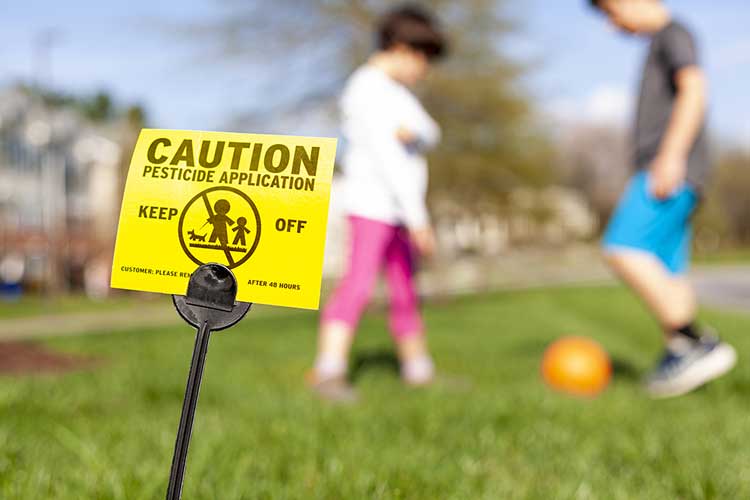Risks from Lawn Care Treatments
Last updated May 2025

Chemicals used in lawn care treatments can enter your body through your skin or eyes, or through inhalation, or be transported from your hands to your mouth. Children may ingest treated grass. Pets and wild animals are also exposed.
Unfortunately, for many chemicals there is little evidence concerning the amount that actually gets into humans as a result of lawn treatments. Most manufacturers are required to test their products for long-term risks and submit the results to the U.S. Environmental Protection Agency (EPA), which reviews the tests and evaluates the findings. But sometimes manufacturers don’t provide thorough testing to the EPA promptly: In 2024, the EPA banned DCPA, a popular herbicide, after asking its manufacturer for nearly 10 years for requested testing data. (The chemical is known to affect fetal thyroid hormones, which can lead to multiple medical conditions.)
Also a concern: Some pesticides and herbicides have not been evaluated using the most advanced scientific procedures, and it is possible that current procedures cannot detect all risks of cancer, mutations, birth defects, reproductive problems, and long-term neurological effects. Many pesticides and herbicides are known to cause allergic reactions for some people.
While there are links between available pesticides and herbicides used in lawn care treatments, and health problems like cancer and birth defects, most studies indicate that these chemicals pose far lower risks when used according to the directions on their labels. So make sure that your exposure to chemicals doesn’t exceed what the labels recommend.
The National Pesticide Information Center (NPIC) collects testing data and has info on possible long- and short-term dangers of pesticides and herbicides. NPIC also provides guidelines for the safe handling and application of control agents.
The environmental threat from chemical lawn care pesticides is unclear. Most of these substances decompose by the time they work their way through lawn turf, though there may be some runoff from areas with thin grass cover, or driveways and sidewalks where pesticides may be spilled or blown. Runoff problems from lawns are usually far less than from agricultural applications, though there isn’t hard data to know the environmental risks.
Chemical pesticides are not the only potential environmental contaminant from lawn care treatments. Fertilizers can pollute waterways.
To minimize health risks from all treatments, read the warning labels on the containers; lawn care services will provide copies of labels upon request. Stay off the lawn for at least several hours after it has been treated, until the chemical is dry; some experts recommend 72 hours or more. Make sure your service posts signs warning that your lawn has been sprayed. But remember that young children and pets can’t read signs.
If a member of your household or a neighbor has a pesticide allergy, insist that your lawn care company not apply pesticides, or notify the neighbor before making treatments.


